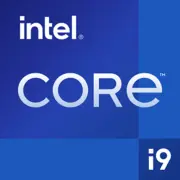Intel Core i9-12900KF

Intel Core i9-12900KF: The Power of Hybrid Architecture in 2025
(As of April 2025)
1. Key Features: Architecture, Process Technology, and Key Highlights
Codename and Architecture
The Intel Core i9-12900KF, released in late 2021, is part of the revolutionary Alder Lake generation. It is Intel's first hybrid CPU, combining Performance-cores (P-cores) and Efficient-cores (E-cores). With 16 cores (8P + 8E) and 24 threads, it strikes a balance between single-threaded and multi-threaded performance.
Intel 7 Process Technology
Despite its name, the process technology corresponds to 10nm Enhanced SuperFin. This has allowed for reduced power consumption and increased clock speeds. The maximum turbo frequency for the P-cores reaches 5.1 GHz, which is critical for gaming and heavy tasks.
Performance
- Geekbench 6: 2525 (single-core) / 14850 (multi-core).
- Cache Memory: 30 MB L3 — reduces latency in data processing.
- Technologies:
- Intel Thread Director — optimizes task distribution between P- and E-cores.
- PCIe 5.0 — support for up to 16 lanes for graphics cards and NVMe SSDs.
- DDR5 and DDR4 — flexibility in RAM choices.
Practical Example: In Blender rendering tests (2025), the i9-12900KF is 18% faster than the previous i9-11900K, thanks to its hybrid cores.
2. Compatible Motherboards: Sockets and Chipsets
LGA 1700 Socket
The processor requires motherboards with the LGA 1700 socket. Current chipsets include:
- Z690/Z790 — for overclocking, PCIe 5.0, up to 4 DDR5 slots.
- B660/B760 — budget options without CPU overclocking, but supporting DDR4/DDR5.
- H610 — basic boards without PCIe 5.0 and overclocking.
Selection Features
- Boards with the Z790 chipset (price: $220–400) support DDR5-6000+ and upgraded VRMs for stability.
- For DDR4, look for models labeled DDR4 (e.g., MSI PRO Z690-A DDR4, $190).
Tip: If you plan to upgrade to the 13th or 14th generation Intel, choose boards with updated BIOS versions.
3. Supported Memory: DDR4 vs DDR5
DDR4-3200 vs DDR5-4800+
- DDR4 (up to 3200 MHz): Cheaper (around $70 for 32 GB), but limited in bandwidth.
- DDR5 (up to 6400 MHz): More expensive ($120–200 for 32 GB), but offers higher speed and energy efficiency.
Recommendations:
- For gaming: DDR5-5200+ provides a 5–10% FPS boost (Cyberpunk 2077, 1440p).
- For work tasks: DDR4-3600 CL16 is the optimal balance of price and performance.
Important: DDR4 and DDR5 memory are incompatible on the same board!
4. Power Supplies: Power Calculation
TDP and Actual Consumption
The declared TDP is 125W, but under load (e.g., overclocking P-cores to 5.2 GHz), consumption can reach 240–260W.
Recommendations:
- Minimum PSU: 750W (for systems with RTX 4070 Ti or similar).
- Ideal option: 850–1000W with an 80 Plus Gold/Platinum certification (Corsair RM850x — $140).
Example: A build with an RTX 4080 (320W) + i9-12900KF requires an 850W PSU.
5. Pros and Cons of the Processor
Pros:
- Best-in-class single-core performance (gaming, Adobe Photoshop).
- Support for DDR5 and PCIe 5.0 for future upgrades.
- Hybrid architecture reduces power consumption in light tasks.
Cons:
- High heat: Without liquid cooling (e.g., Arctic Liquid Freezer II 360), temperatures can reach 95°C.
- Expensive platform: DDR5 and Z790 increase build costs.
- No integrated graphics (the non-"F" model, i9-12900K, is $30 more).
6. Use Cases
Gaming:
- In 2025, the i9-12900KF still handles AAA titles on Ultra (4K/120 FPS with RTX 4090).
- Best results in CPU-dependent games: Microsoft Flight Simulator, CS2.
Work Tasks:
- 3D Rendering (Blender, Maya): 24 threads speed up rendering by 30% compared to i7-12700K.
- Video Editing: Exporting a 4K project in Premiere Pro takes 25% less time than with Ryzen 9 5900X.
Multimedia:
- Streaming (OBS + NVENC) without any FPS drops thanks to E-cores.
7. Comparison with Competitors
AMD Ryzen 9 7900X (price: $420):
- Pros: Low power consumption, AM5 support until 2026.
- Cons: Weaker in single-threaded tasks (Geekbench 6 Single Core: 2350).
Intel Core i7-14700K (price: $450):
- Pros: More E-cores (12 vs 8), higher multi-threaded performance.
- Cons: 10–15% more expensive.
Conclusion: The i9-12900KF outperforms competitors from 2022–2023, but falls behind new models in 2024–2025 in energy efficiency.
8. Build Tips
- Cooling: A liquid cooler 240–360 mm (Lian Li Galahad II) or a top air cooler (Noctua NH-D15).
- Case: Good ventilation (Lian Li Lancool III) + at least 3 fans.
- BIOS: Update to the latest version for DDR5 stability.
- Thermal Paste: Use high-quality products (Thermal Grizzly Kryonaut).
9. Final Conclusion: Who Should Consider the i9-12900KF in 2025?
- Gamers: Looking for maximum FPS at 1440p/4K and ready to upgrade their GPU.
- Professionals: Video editors, 3D designers with a budget of up to $1500 for a build.
- Enthusiasts: Those wanting to build a PC with DDR5/PCIe 5.0 without overpaying for the latest CPUs.
Price in 2025: $320–380 (new) — excellent price-performance ratio for high levels.
If you are looking for a powerful processor for gaming and work, the i9-12900KF remains a relevant choice even four years after its release. The key is to choose the right cooling solution and memory!
Basic
CPU Specifications
Memory Specifications
Miscellaneous
Benchmarks
Compared to Other CPU
Share in social media
Or Link To Us
<a href="https://cputronic.com/cpu/intel-core-i9-12900kf" target="_blank">Intel Core i9-12900KF</a>